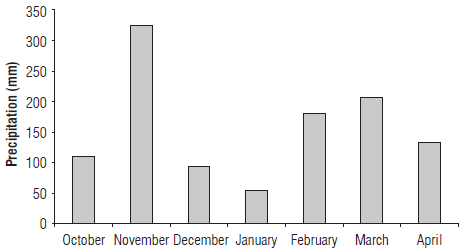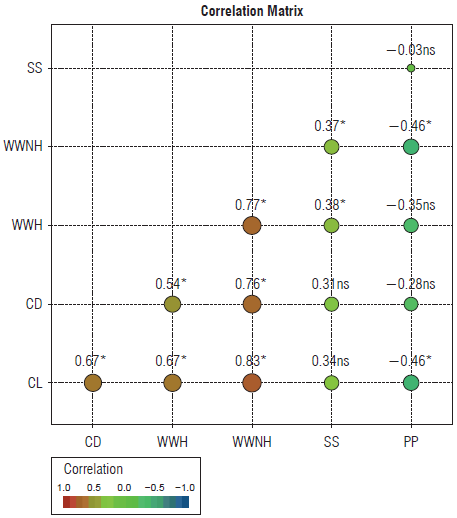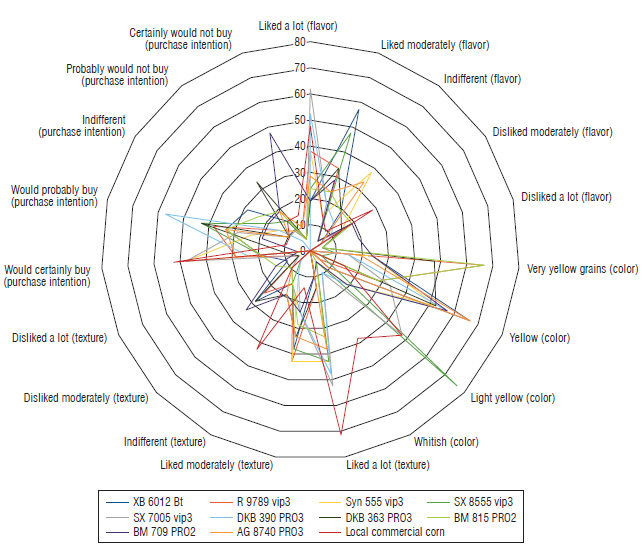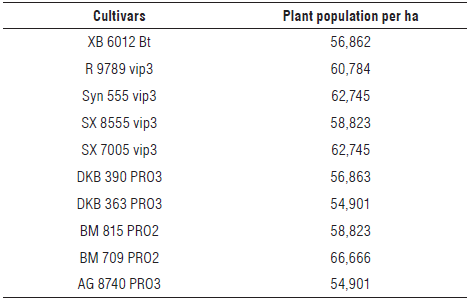Introduction
Brazil is one of the largest producers and exporters of agricultural products in the world. Grains, mainly soybeans and corn, show rapid growth in production and productivity due to the geographic expansion in the Midwest region of the country and the adoption and diffusion of technological innovations (Borlachenco & Gonçalves, 2017). Corn (Zea mays L.) is classified within the group of C4 plants and shows good edaphoclimatic adaptations, allowing its cultivation in varied places. Corn production for the 2019/2020 harvest exceeded 100 million t of grain, in an area of approximately 18.2 million ha (Conab, 2019).
Low average productivity of corn is usually directly related to the low investment capacity of producers for improved seeds adapted to a particular planting location that is associated with losses caused by biotic and abiotic factors.
For satisfactory growth and development, corn depends on water availability and temperature and solar radiation at ideal levels for the crop (Machado et al, 2020). Additionally, the selection of genetic material suitable and adapted for each region of cultivation (genotype x environment interaction) is a fundamental factor that guarantees good results. So, it is expected that the material can express its genetic potential (Cruz et al., 2011).
In addition to its importance for grain production, the corn crop is important for cob production for fresh consumption, popularly known as "green corn" production. The cultivation of green corn has aroused interest among farmers in Brazil, as a demand exists throughout the year providing income due to its popular acceptance and the possibility of good prices.
In this sense, there are hybrids destined, for example, to the production of grains that can be interesting options for the cultivation of green corn, so they may be considered hybrids with double aptitude (Rodrigues et al., 2009; Costa et al, 2015).
Green corn is the corn harvested and consumed while still fresh, when the grains exhibit approximately 70 to 80% humidity and before there is a conversion of sugar into starch (stage R3 of development). The time required to reach this phenological stage may vary between different genotypes (Barbieri et al, 2005).
For the production of green corn, it is necessary to evaluate characteristics considered desirable for its cultivation as well as for commercialization, such as the commercial percentage of cobs, weight of cobs, diameter of cobs, and yellow grains with straight alignment. This is because commercialization is based on these attributes, in addition to the analysis of sensory acceptability, an extremely important characteristic in this market (Rodrigues et al, 2018).
Consumer acceptability can be determined by sensory analysis that corresponds to the sensations arising from physiological reactions, through stimuli that generate interpretations for each product. The sensations produced by psychological effects and the stimuli produced by physicalchemical effects quantify the sensations of the product (Albuquerque et al, 2008).
In the Pontal do Triângulo Mineiro region, there is no tradition for the production of grains, especially corn. The economy is focused, in general, on extensive livestock and sugar cane production. In recent years, there has been an increase in the search for more information and, consequently, more knowledge by local producers about the corn crop and its various applications, grain production, silage, and green corn production. In this sense, research focused on evaluating the behavior of different corn materials in this region is necessary to meet possible future demands and to understand the potential of different genotypes fitting the environmental conditions in the region.
This study aimed to characterize different corn hybrids grown in the Pontal do Triângulo Mineiro region, with respect to the agronomic characteristics of importance and the preference of local consumers.
Materials and methods
Genetic material and experimental conditions
This experiment was carried out under "dryland" conditions during the 2018/19 harvest in the municipality of Iturama, Minas Gerais, Brazil (19°43'20" S, 50°11'37" W, and 474 m a.s.l). The experimental area belongs to the Rural Producers Union of Iturama and its soil is classified as a sandy Latosol with a sandy texture having the following chemical characteristics (0-20 cm) (Van Raij et al, 2001): P(resin): 15 mg dm-3; organic matter: 17 g dm-3; pH (Cacl2)4.3; S: 3 mg d m-3; Ca, Mg, К, H+Al, and Al: 12, 4, 0.8, 34, and 4 mmolc d m-3, respectively. Average precipitation is shown in Figure 1.

FIGURE 1 Average precipitation for the municipality of Iturama, Minas Gerais, Brazil, during the 2018/19 harvest.
In the 2017/18 harvest, the soil was corrected with 3 t ha-1 of dolomitic limestone incorporated with a plow harrow. Subsequently, 1 t ha-1 of plaster was applied to the area occupied by corn (silage) in the first harvest and sorghum (silage) in the second harvest.
For implementation of the experiment (2018/19 harvest), the area was desiccated with 2000 g of active ingredient (a.i.) ha-1 of glyphosate and then scarification and leveling with a leveling grid were carried out. The crop was planted with a 0.80 m interline spacing with 60,000 seeds per ha on November 28th, 2018. Fertilization at planting was carried out with 320 kg ha-1 of the formula 06-24-12 (sowing furrow) and 350 kg ha-1 of 20-00-20 in cover (vegetative development phase V3). For weed management, spraying was carried out at V3 with 1,500 g a.i. ha-1 of atrazine with manual weeding control. Management of the corn leaf-hopper (Dalbulus maidis) and fall armyworm (Spodoptera frugiperda) was performed with two applications of 120 g a.i. ha-1 of imidacloprid + 10 g a.i. ha-1 of lambda-cyhalothrin + 20 g a.i. ha-1 of chlorantraniliprole (V2 and V3).
Plant material evaluated consisted of 10 commercial corn hybrids: XB 6012 Bt, R 9789 vip3, Syn 555 vip3, SX 8555 vip3, SX 7005 vip3, DKB 390 PRO3, DKB 363 PRO3, BM 815 PRO2, BM 709 PRO2, AG 8740 PRO3. For the sensory analysis, a commercial hybrid was added as control of local preference for consumption as green corn, purchased in a supermarket in the municipality of Iturama.
The experimental design used was in randomized blocks with three replicates. The plots consisted of eight 10-m-long lines, and the six central lines were considered useful for the purpose of data collection and observations.
Evaluation of productive performance of corn hybrids
To evaluate the performance of the different hybrids, the following characteristics were evaluated: cob length (CL) (cm) and cob diameter (CD) (mm), measured using a digital caliper from the brand Mitutoyo with an accuracy of 0.05 mm; weight with husks (WWH) (g) and weight without husks (WWNH) (g) determined using a portable digital high-precision scale (STC02) with a capacity of up to 50 kg; soluble solids content (SS) (°Brix), obtained through a corn juice aliquot, compressed by a gauze and quantified by a field refractometer (PR-101, Atago, Tokyo, Japan). Plant population per ha (PP) was obtained by counting plants for each hybrid in an area of 3.2 m2 (2 lines of 4 m of crop line x 0.8 m of spacing between lines) as well as a conversion into the average estimate of plants per ha.
The evaluations for the characteristics CL, CD, WWH, WWNH and SS were obtained as the average of the total from five cobs. Harvest was carried out manually, as well as the husking of the cobs in the R3 phase of the crop. Data obtained were subjected to analysis of variance (ANOVA) and the means were compared by the Scott-Knott test at 1% probability level using the statistical program RBio (Bhering, 2017).
Analysis of the sensory profile of corn hybrids
In addition to the evaluation of agronomic characteristics, a sensory analysis was carried out at the Chemistry Laboratory at the Federal University of Triângulo Mineiro (UFTM) where flavor, color, texture and purchase intention of the corn cobs were evaluated. The sensory test was performed with 21 people (volunteers from UFTM) and characteristics were evaluated on a scale of grades. For the flavor and texture characteristics, the scale consisted of 1 (liked a lot), 2 (liked moderately), 3 (indifferent), 4 (disliked moderately) and 5 (disliked a lot). For the coloring, the scale consisted of 1 (very yellow grains), 2 (yellow), 3 (light yellow) and 4 (whitish). Purchase intention was evaluated on a scale of 1 (would certainly buy), 2 (would probably buy), 3 (indifferent), 4 (probably would not buy) and 5 (certainly would not buy).
Samples for sensory analysis consisted of pieces of approximately 5 cm in length from each of the cobs, corresponding to each of the 11 corn hybrids. These were cooked in a pressure cooker at 180°C for 20 min. Subsequently, the samples were served at room temperature (25°C) in disposable cups encoded with random numbers of three digits. Together with the sample, the evaluators received the analysis sheet with a scale of grades and a glass of water to rinse the mouth between tasting one sample to another, avoiding interference with the results.
Results and discussion
Evaluation of the productive performance of corn hybrids
The corn hybrids were harvested on February 20th, 2019, 84 d after sowing. After harvesting and evaluating the characteristics, the data were subjected to analysis of variance (ANOVA) at 1% probability level, using the statistical program RBio. Based on the results obtained, a significant difference was observed for the characteristics of cob length, cob diameter, weight with husks, and weight without husks (Tab. 1). There was no significant difference between blocks, so the experimental area was more homogeneous.
TABLE 1 Analysis of variance for the cob length (CL), cob diameter (CD), weight with husks (WWH), weight without husks (WWNH), soluble solids content (SS), plant population per ha (PP) of corn.

**Significant at 1% probability; NS - not significant; SV - source of variation; DF - degree of freedom; MS - medium square; CV - coefficient of variation.
Based on the results of the ANOVA, for the characteristics that were significant, the averages were grouped by the Scott-Knott test at 1% probability using the RBio program (Tab. 2).
TABLE 2 Average values of cob length (CL) (cm), cob diameter (CD) (mm), weight with husks (WWH) (g), and weight without husks (WWNH) (g) of corn.

Means followed by the same letters do not differ significantly according to the Scott-Knott test at 5% probability level.
For the cob length and weight without husks, the hybrids XB 6012 Bt, R 9789 vip3, SX 8555 vip3, SX 7005 vip3, and BM 709 PRO2 stood out with the highest values (Tab. 2).
The cob length showed values between 20.84 cm (BM 709 PRO2) and 15.58 cm (DKB 390 PRO3). The average weight of a cob without husks ranged from 277.78 g (R 9789 vip3) to 167.78 g (AG 8740 PRO3).
The hybrid BM 709 PRO2 differs significantly from the others for cob diameter. This hybrid showed an average value of 46.54 mm for this variable, which is higher than that found for the other evaluated cultivars. The hybrid BM 709 PRO2 had significant potential for commercialization as green corn, standing out in relation to the others due to the greater cob length and larger cob diameter. The same could be said for the hybrids XB 6012 Bt, R 9789 vip3 and SX 8555 vip3, although they had a smaller cob diameter than the hybrid BM 709 PRO2.
For the production of green corn, it is desirable to obtain high commercial cob weight since its commercialization is dependent on this characteristic. Cobs larger than 15 cm in length and 3 cm in diameter are considered as commercial cob patterns (Grigulo et al., 2011; Rodrigues et al., 2018). Therefore, despite the prominence of some hybrids, in general, all the evaluated materials showed cob length and cob diameter considered ideal for commercialization as green corn.
For the weight of the cob with husks, the values observed ranged from 226.67 g (DKB 390 PRO3) to 488.89 g (R 9789 vip3). The cultivar R 9789 vip3 differed significantly from the others due to its higher value (488.89 g). It is important to highlight that the weight of the cob with husks must be evaluated in the production of green corn since for processing or consumption in natura, the cobs are usually transported with the husk to the final destination. This is done to avoid sugar degradation and product denaturation as well as physical damage caused by transportation. Thus, the aim is to maintain the sweet taste of cobs for commercialization (Rodrigues et al., 2009; Grigulo et al., 2011).
In addition to the cluster analysis of means, we estimated the correlation between the variables evaluated (Fig. 2). The correlation measures the degree of association between two variables. High correlations between two characters indicate that the change in one character, via selection, promotes changes in the other. The correlation can be positive when it is possible to obtain gains for one variable by selecting another, or negative when the selection in one variable will negatively contribute to another (Resende, 2002). This strategy allows for rapid progress, via indirect selection, as it allows selecting variables that have complex inheritance and that are difficult to measure, through another correlated variable that is easier to measure (Oliveira et al, 2011).
The highest values of positive correlation were observed between the variables weight without husks and cob length (0.83), weight without husks and weight with husks (0.77), weight without husks and cob diameter (0.76), weight with husks and cob length (0.67), cob diameter and cob length (0.67), and weight with husks and cob diameter (0.54) (Fig. 2). Considering the direction and magnitude of these correlations, the selection for these variables would be advantageous since it seeks to obtain plants with greater weight without husks and with greater cob length and diameter.
The highest values of negative correlation were observed between the variables plant population per ha and weight without husks (-0.46) and plant population per ha and cob length (-0.46). This result was expected, since the larger the plant population, the greater the competition between plants (intraspecific competition) and, consequently, this will result in shorter cob lengths and lower cob weight without husks.
In this study, it was possible to verify that the average estimate of the population of plants per ha varied from 54,901 (AG 8740 and DKB 363) to 66,000 plants per ha (BM 709 PR02) (Tab. 3).
Considering that the production focused on green corn, it is important to evaluate the plant population per ha since for this type of market the ideal is to work with an adequate plant population to obtain cobs with the appropriate weight and sizes for consumption as green corn. Corn is the crop of the grass group that is most sensitive to variation in plant density, and some researchers consider the genotype itself as the main determinant of density (Pricinotto et al, 2019).

FIGURE 2 Correlation between the variables cob length (CL), cob diameter (CD), weight with husks (WWH), weight without husks (WWNH), soluble solids content (SS), plant population per ha (PP) of corn. * and ns - significant and non-significant correlations, respectively, at the 5% probability level (P<0.05) according to the T test.
Analysis of the sensory profile of corn hybrids
Based on the sensory analysis, we observed for the flavor that the hybrids SX7005 vip3, DKB 390 PR03, and XB 6012 Bt showed greater acceptance by the evaluators, with the first two surpassing the "local commercial control" (Fig. 3).

FIGURE 3 Analysis of the sensory profile of corn hybrids according to the scale of grades to assess taste, color, texture, and purchase intention.
For the color of the corn cobs, most of the evaluators preferred the cobs with yellow and light-yellow coloring, such as XB6012 Bt (77%), SYN 555 vip3 (71%), DKB 363 PR03 (52%), DM 709 PR02 (75%), AG 8740 PR03 (78%), and SX 8555 vip3 (80%) (Fig. 3). Pereira Filho et al (2002), studying different corn hybrids, found that cobs with lighter colored grains are preferred, when the product is intended for consumption of green corn in natura. The color of the corn endosperm is controlled by a gene that gives the yellow color with a dominant homozygote and the white color with a recessive homozygote that directly interferes with acceptance by the final consumer (Barbieri et al, 2005).
The corn hybrids that showed a soft texture and were more pleasant to the evaluators were SX 7005 vip3 (78%) and DBK 390 PR03 (73%) that was slightly below the local commercial hybrid that showed 86% acceptance (Fig. 3). It is important to note that texture is related to the thickness of the pericarp, so the thicker the pericarp, the greater the resistance to chewing. This characteristic is also influenced by the stage of grain maturation, that is, the more mature the grain, the thicker the pericarp and the lesser the acceptance related to texture (Barbieri et al, 2005; Camilo et al, 2015).
The purchase intention parameter was evaluated at the end of the sensory test. The hybrids SYN 555 vip3 (73%), SX 7005 vip3 (85%), DKB 390 PR03 (80%) and the local commercial hybrid (62%) were the most accepted for purchase by the evaluators (Fig. 3). The hybrids with the best acceptability were harvested approximately 50 d after flowering. According to this research, the included hybrids showed acceptance of purchase higher than the local commercial hybrid.
Based on the sensory analysis, we verified that the hybrids SX 7005 vip3 and DKB 390 PR03 stood out in flavor and texture, surpassing the local commercial corn. This result directly affected the purchase intention analysis, in which approximately 80% and 85% of people would buy the hybrids DKB 390 PR03 and SX 7005 vip3, respectively.
As there are still few corn hybrids on the market that produce green corn, these can be an option for small producers when harvested at the right time, with high moisture and sugar content in the grains. In this way, the producer will select the hybrid that shows the best productive and sensorial characteristics to ensure consumer satisfaction.
Conclusions
Under the edaphoclimatic conditions of the region of the municipality of Iturama, located in the Pontal do Triângulo Mineiro region, Brazil, the hybrids XB6012 Bt, R9789 vip3, SX 8555 vip3, SX 7005 vip3, and BM709 PR02 showed outstanding characteristics for the fresh corn consumer market. It is worth mentioning that the hybrid BM 709 PR02 has significant potential for commercialization as green corn, standing out in relation to the others, due to the greater length and diameter of the cob, besides being among the hybrids with greater weight of the cob without husks. Based on the sensory analysis, the hybrids SX 7005 vip3 and DKB390 PRO3 stood out in terms of flavor and texture, surpassing the local commercial corn, which resulted in greater acceptability (purchase intention) by the evaluators.















